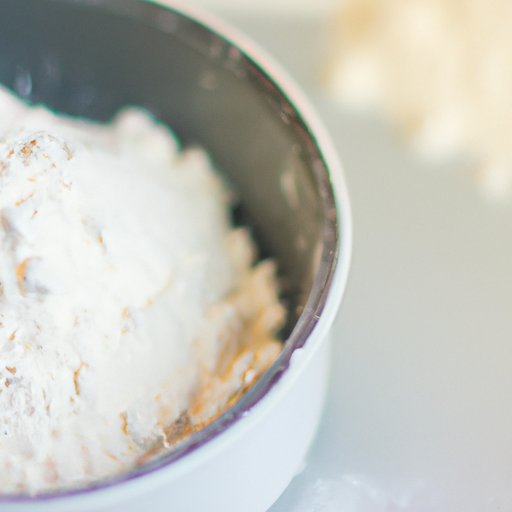Introduction
Baking is an art that requires precision and attention to detail. One of the most important elements of baking is measuring ingredients accurately, especially flour. However, many people struggle with determining how many cups of flour are in a pound, leading to inaccurate measurements and disappointing results. In this article, we will provide a comprehensive guide to measuring flour accurately and explore common mistakes to avoid.
The Complete Guide to Measuring Flour: How Many Cups in a Pound?
Flour is a staple ingredient in many baked goods, whether you’re making a classic chocolate chip cookie or a rich banana bread. Most recipes call for flour to be measured in cups, but the amount of flour in a cup can vary based on factors like sifting and scooping. It is important to note that the standard measurement for flour is based on scooping the flour directly into the measuring cup and leveling it off with a knife or spatula.
To convert cups to pounds and vice versa, it is necessary to understand the weight of a cup of flour. One cup of all-purpose flour weighs approximately 125 grams. A pound of flour is equivalent to 453 grams, so there are approximately 3.6 cups of flour in a pound. However, it’s important to note that different types of flour have different weights and conversion rates.
For example, whole wheat flour is denser and weighs more than all-purpose flour. One cup of whole wheat flour weighs approximately 130 grams, so there are approximately 3.5 cups of whole wheat flour in a pound. Similarly, one cup of bread flour weighs approximately 136 grams, so there are approximately 3.3 cups of bread flour in a pound.
Baking Basics: Understanding the Ratio of Flour to Pound
The amount of flour in a recipe affects the texture and structure of the final product. Understanding the ratio of flour to other ingredients is essential to achieving the desired result. For example, a recipe with a higher ratio of flour to liquid will yield a denser, more bread-like texture. A recipe with a lower ratio of flour to liquid will yield a lighter, more cake-like texture.
Common recipes that use different ratios of flour to other ingredients include cakes, cookies, bread, and pastries. When adjusting a recipe based on the amount of flour needed, it’s important to keep the ratio of flour to other ingredients in mind. This will help ensure that the final product has the desired texture and structure.
Expert Tips for Measuring Flour: Avoiding Common Mistakes
Measuring flour accurately is essential for successful baking, but it’s easy to make mistakes. One of the most common mistakes people make when measuring flour is using too much flour, which can lead to dense, dry, or tough baked goods. Another common mistake is not fluffing the flour before measuring, which can result in a compacted and dense measurement.
To avoid these mistakes and measure flour accurately, try using a kitchen scale to weigh the flour instead of relying solely on cup measurements. If using a measuring cup, fluff the flour with a fork or whisk before scooping it into the cup. Then, use a knife or spatula to level off the top of the cup.
Another helpful tip is to be gentle when measuring. Do not pack the flour down or shake the measuring cup. Use a light hand when scooping the flour into the measuring cup.
A Handy Guide to Converting Flour Measurements: Cups to Pounds
To make measuring flour even easier, here is a handy guide to common flour conversions:
| Flour Type | Weight per cup | Cups per pound |
|---|---|---|
| All-Purpose Flour | 125 grams | 3.6 cups |
| Whole Wheat Flour | 130 grams | 3.5 cups |
| Bread Flour | 136 grams | 3.3 cups |
If a recipe gives flour measurements in pounds, use the chart above to convert pounds to cups. For example, if a recipe calls for 2 pounds of all-purpose flour, you will need approximately 7.2 cups of flour.
Scaling Recipes for Success: Why Measuring Flour by Weight is Key
Measuring flour by weight is more accurate than using cup measurements. This is because the weight of flour can vary greatly depending on how it is measured. By using a kitchen scale, you can ensure that you are using the exact amount of flour called for in a recipe.
When adjusting a recipe based on a change in flour measurement, it’s important to keep the ratio of flour to other ingredients in mind. For example, if you are doubling a recipe that calls for 2 cups of flour, you will need to use 7.2 cups of flour (based on the all-purpose flour conversion chart above).
To use a kitchen scale to measure flour by weight, place the bowl or container on the scale and reset it to zero. Add the flour to the bowl until you reach the desired weight.
Bake Like a Pro: Mastering Flour Measurements in Your Recipes
Mastering flour measurements is essential for successful baking. Practicing and perfecting your flour measuring skills takes time and patience, but the results are worth it. Use the tips and advice shared in this article to achieve the perfect texture and structure in your baked goods.
If you encounter problems with inaccurate flour measurements, remember to troubleshoot common mistakes and adjust the recipe as needed. With time and practice, you’ll be baking like a pro in no time!
Conclusion
Measuring flour accurately is an essential component of successful baking. By understanding the weight of flour, the ratio of flour to other ingredients, and the common mistakes to avoid, you can achieve perfect results every time. Mastering flour measurements takes practice, but the benefits are immense. Follow the tips and advice shared in this article to take your baking to the next level.
